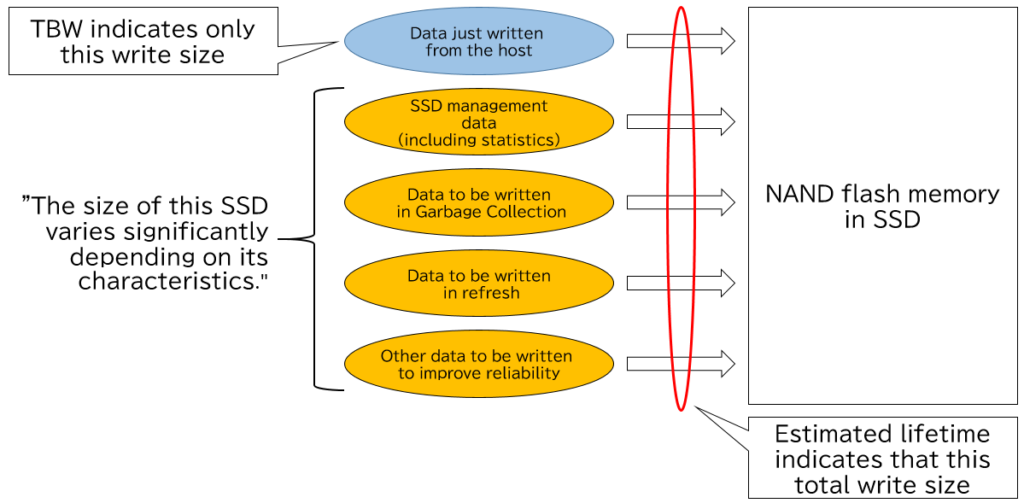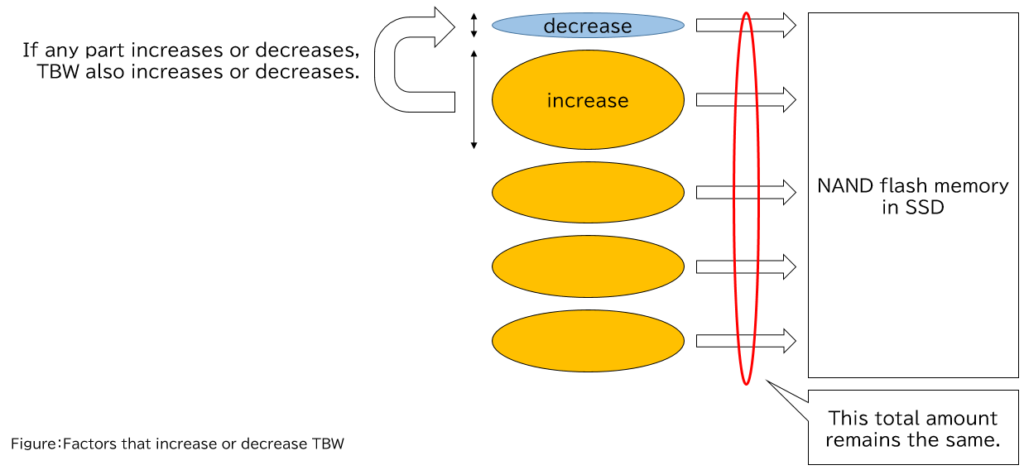
Products related to this article
- SATA SSD SN2S-GP Series
- NVMe SSD HN8E Series
*This article is a revised version of an article posted to Qiita in October 2019.
Introduction
In the previous article, we explained the definition of TBW and the meaning of its description in SSD product specifications.
Therefore, this article explains what TBW is.
Summary
- TBW is the maximum data size (i.e., lifetime) that can be written to NAND flash memory installed in an SSD by the host under defined conditions (e.g., workload)
- TBW varies even for the same NAND flash memory and the same capacity, depending on the workload and SSD characteristics.
Preparation: Estimated Life Span
For the purpose of the explanation that follows, we define a simplified SSD lifetime, “estimated lifetime,” which can be calculated based on the capacity of the NAND flash memory mounted by the SSD and the guaranteed number of rewrites of the NAND flash memory.

Note that this “estimated life” is only a simplified value introduced for illustrative purposes.
Now we will calculate the estimated lifetime in detail. We will use a 960 GB model of our SATA SSD SN2S-GP series with 3D TLC NAND flash memory and a 640 GB model of our NVMe SSD HN8E series. The calculation results are shown in the table below.

Difference between estimated life and TBW
As shown in the table above, there is a difference between the estimated lifetime and the TBW calculated using the JESD219 client workload listed in the product specifications for both products. In both cases, the estimated lifetime is greater.
The reason for this difference is that the estimated lifetime is “the total size that can be written to the NAND flash memory mounted in the SSD” and TBW is “the size that can be written from the host to the SSD.
In addition to newly written data from the host, SSDs write a variety of other data to NAND flash memory. Examples include SSD management information, statistical information represented by SMART, and data copied by Garbage Collection. Other data may also be written to NAND flash memory through refresh and other processes that ensure data reliability.
This is illustrated in the figure below.

As shown in this figure, TBW indicates only the data newly written from the host, while the estimated lifetime indicates all the data written to the NAND flash memory in the SSD, so the estimated lifetime is always larger.
Identity of TBW
Now we are ready to explain what TBW is.
In the previous article, we explained that TBW is the maximum size that a host can write to an SSD under defined conditions (e.g., workload).
And in this article, we explained that there are various types of data written to the NAND flash memory that SSDs are equipped with, in addition to data written from the host.
From these two, the TBW in the SSD catalog is the maximum size that can be consumed by newly written data from the host, of the guaranteed write data size of the NAND flash memory that the SSD contains.
Factors influencing TBW
As shown in the figure above, TBW is only one element that consumes the limited lifetime of the NAND flash memory in the SSD, and there are other elements that consume the lifetime of NAND flash memory.
In other words, it can be said that the factor that determines the size of TBW is the magnitude of factors other than TBW that consume the life of the NAND flash memory mounted by the SSD (see figure below).

They include, specifically, the size of SSD management data, the size of data written by Garbage Collection, and even the size of data written to improve reliability.
In general, random writes in a large LBA space result in frequent Garbage Collection. In this case, the data size written by Garbage Collection increases and TBW decreases.
In other words, TBW depends on the workload (access pattern) for the same SSD.
In the case of SSDs with characteristics that place particular emphasis on data reliability, the size of data to be written may be increased for the purpose of improving reliability, or the frequency of management data writes may be increased to protect SSD management data. In such SSDs, the size of data to be written for SSD management data and for improving reliability increases, and TBW decreases.
In other words, TBW also depends on the characteristics of the SSD.
For example, our SSDs are equipped with features that improve data reliability and long-term stable operation.
Depending on how these products are used, there may be an increase in the amount of data written due to processes such as refresh to improve reliability, or an increase in the amount of SSD management data written to ensure stable operation. When such processes are performed, the resulting TBW will be somewhat smaller.
Conclusion
In this article, we have explained what TBW is and what factors can increase or decrease TBW.
In the next article in this series, we will explain how to use this TBW to reduce (decrease), or in other words, how to use it to shorten its life.
Trademarks of Other Companies
Although registered trademark marks are not indicated in the articles, company names and product names appearing in the articles are generally trademarks or registered trademarks of the respective companies.
About the article
The content of this article is information at the time of publication. Please note that the information is subject to change without notice.


